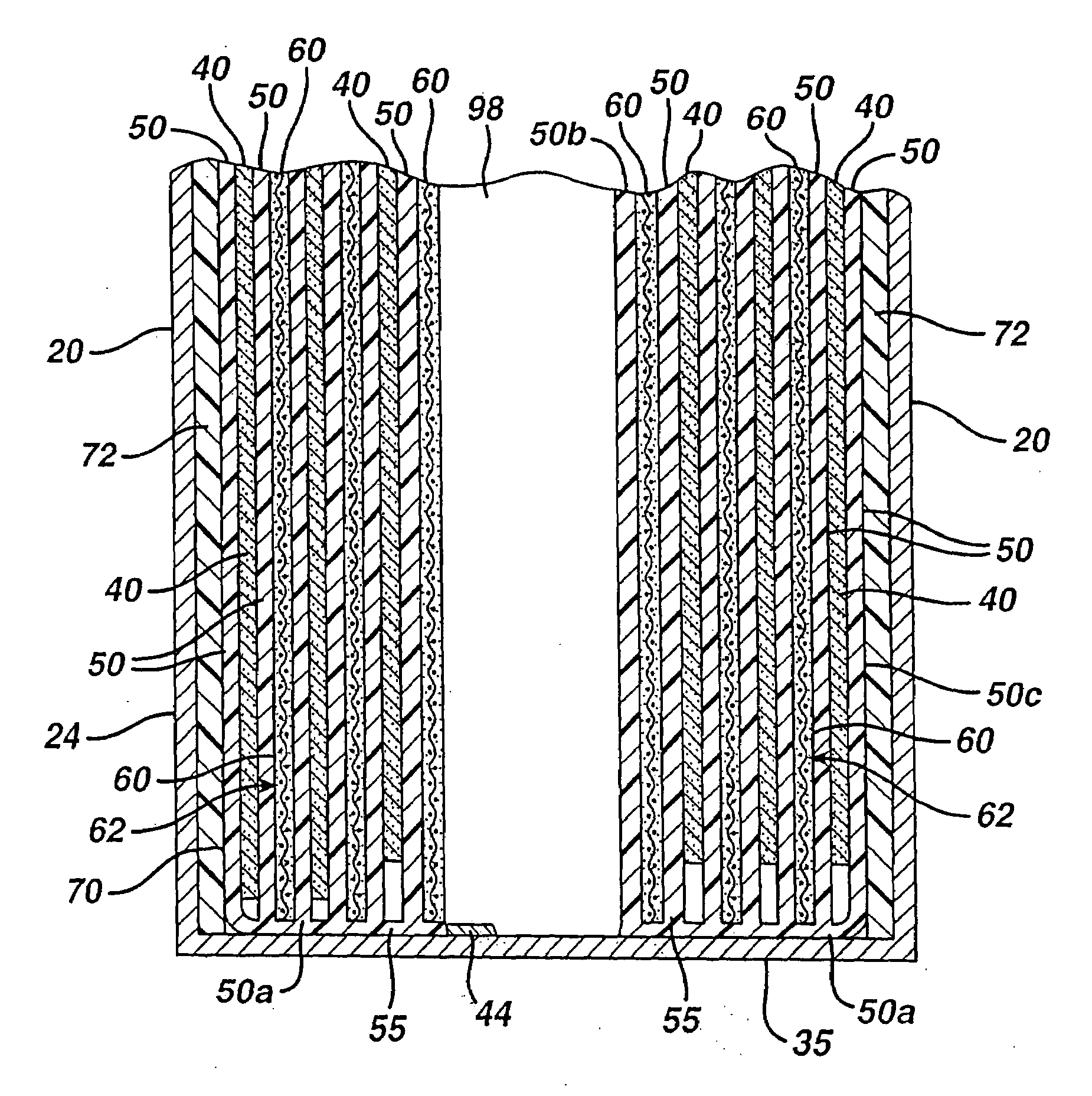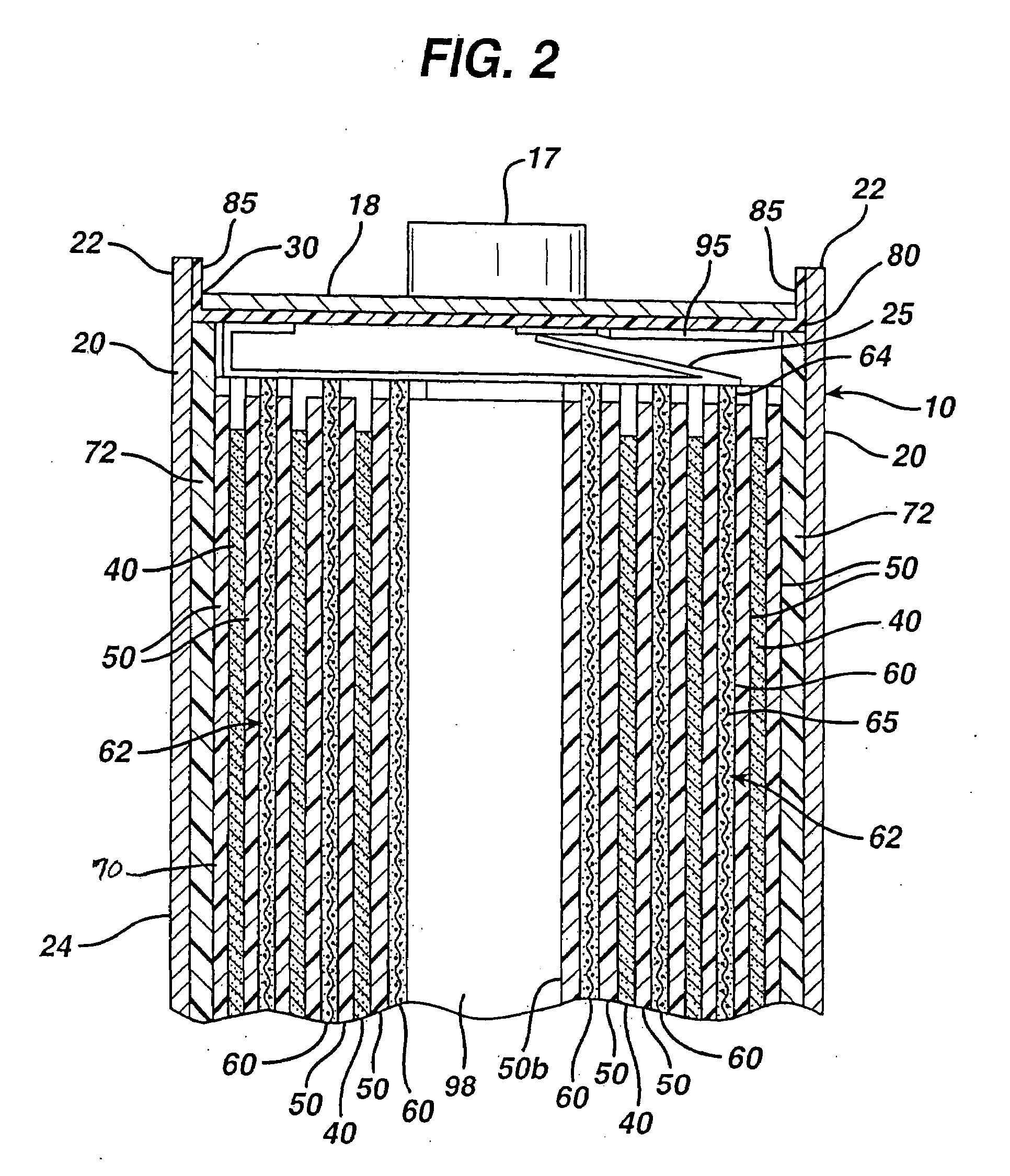Lithium cell cathode
a lithium cell and cathode technology, applied in the direction of non-aqueous electrolyte cells, cell components, sustainable manufacturing/processing, etc., can solve the problems of reducing the effectiveness of the cathode, excessive gassing, cell failure, etc., and achieves the effect of facilitating the removal of contaminants and reducing the physiochemical properties of the kraton binder
Active Publication Date: 2009-03-19
DURACELL U S OPERATIONS
View PDF23 Cites 24 Cited by
- Summary
- Abstract
- Description
- Claims
- Application Information
AI Technical Summary
Benefits of technology
[0039]It has been determined that baking of the cathode coating on the conductive substrate in the above indicated atmospheres allows use of the above elevated baking temperatures without causing deterioration in the physiochemical properties of the Kraton binder. These higher baking temperatures (between 250° C. and 375° C., preferably between about 290° C. and 350° C.) are preferred, since they result in easier removal of the contaminants from the FeS2 particles wit
Problems solved by technology
One of the difficulties associated with the manufacture of a Li/FeS2 cell is the need to add good binding material to the cathode formulation to bind the Li/FeS2 and carbon particles together in the cathode.
This is because undesirable oxidation/reduction reactions between the electrolyte and electrode materials (either discharged or undischarged or partially discharged) could gradually contaminate the electrolyte and reduce its effectiveness or result in excessive gassing.
This in turn can result in a cell failure.
In fact there is no indication that any particular method of drying of the wet cathode or subsequent heat treatment of the dried cathode would be desirable or lead to better results.
It is stated: “Decomposition products resulting from the reaction of FeS2 with moisture are acidic in nature, and their introduction into the cell containing lithium is
Method used
the structure of the environmentally friendly knitted fabric provided by the present invention; figure 2 Flow chart of the yarn wrapping machine for environmentally friendly knitted fabrics and storage devices; image 3 Is the parameter map of the yarn covering machine
View moreImage
Smart Image Click on the blue labels to locate them in the text.
Smart ImageViewing Examples
Examples
Experimental program
Comparison scheme
Effect test
 Login to View More
Login to View More PUM
| Property | Measurement | Unit |
|---|---|---|
| Temperature | aaaaa | aaaaa |
| Temperature | aaaaa | aaaaa |
| Temperature | aaaaa | aaaaa |
Login to View More
Abstract
A primary cell having an anode comprising lithium and a cathode comprising iron disulfide (FeS2) and carbon particles. The electrolyte comprises a lithium salt dissolved in a solvent mixture. Iron disulfide powder and carbon black is preferably premixed and stored. A cathode slurry is prepared comprising iron disulfide, carbon black, binder, and a liquid solvent. The mixture is coated onto a substrate and solvent evaporated leaving a dry cathode coating on the substrate. The cathode coating is then baked at elevated temperatures in atmosphere under partial vacuum or in an atmosphere of nitrogen or inert gas. The anode and cathode can be spirally wound with separator therebetween and inserted into the cell casing with electrolyte then added.
Description
CROSS REFERENCE TO RELATED APPLICATIONS[0001]This application is a continuation in part application of application Ser. No. 11 / 901,214, filed Sep. 14, 2007.FIELD OF THE INVENTION[0002]The invention relates to a method of preparing a cathode for a lithium primary cell having an anode comprising lithium metal or lithium alloy and a cathode comprising iron disulfide and an electrolyte comprising a lithium salt and solvents.BACKGROUND[0003]Primary (non-rechargeable) electrochemical cells having an anode of lithium are known and are in widespread commercial use. The anode is comprised essentially of lithium metal. Such cells typically have a cathode comprising manganese dioxide, and electrolyte comprising a lithium salt such as lithium trifluoromethane sulfonate (LiCF3SO3) dissolved in a nonaqueous solvent. The cells are referenced in the art as primary lithium cells (primary Li / MnO2 cells) and are generally not intended to be rechargeable. Alternative primary lithium cells with lithium ...
Claims
the structure of the environmentally friendly knitted fabric provided by the present invention; figure 2 Flow chart of the yarn wrapping machine for environmentally friendly knitted fabrics and storage devices; image 3 Is the parameter map of the yarn covering machine
Login to View More Application Information
Patent Timeline
 Login to View More
Login to View More IPC IPC(8): B05D3/02H01M4/58H01M4/1397H01M4/587H01M10/0587
CPCH01M2/1235Y10T29/49108H01M4/1397H01M4/364H01M4/581H01M4/5815H01M4/587H01M4/621H01M4/622H01M4/625H01M6/16H01M10/0587H01M2004/028Y02E60/122Y10T29/49115H01M4/0471H01M50/342Y02E60/10Y02P70/50H01M4/58
Inventor POZIN, MICHAELCHANG, SEAN
Owner DURACELL U S OPERATIONS
Features
- R&D
- Intellectual Property
- Life Sciences
- Materials
- Tech Scout
Why Patsnap Eureka
- Unparalleled Data Quality
- Higher Quality Content
- 60% Fewer Hallucinations
Social media
Patsnap Eureka Blog
Learn More Browse by: Latest US Patents, China's latest patents, Technical Efficacy Thesaurus, Application Domain, Technology Topic, Popular Technical Reports.
© 2025 PatSnap. All rights reserved.Legal|Privacy policy|Modern Slavery Act Transparency Statement|Sitemap|About US| Contact US: help@patsnap.com



